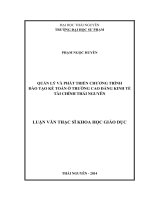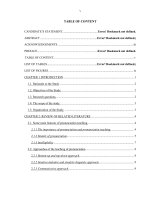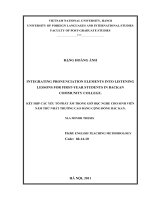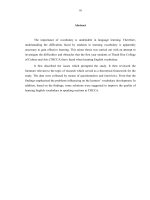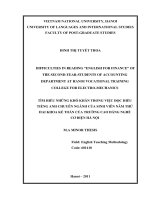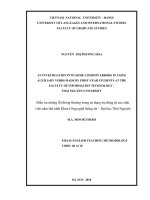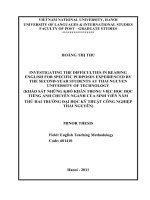Các lỗi phát âm tiếng anh thường gặp của sinh viên năm thứ nhất trường cao đẳng kinh tế tài chính thái nguyên
Bạn đang xem bản rút gọn của tài liệu. Xem và tải ngay bản đầy đủ của tài liệu tại đây (535.35 KB, 65 trang )
THAI NGUYEN UNIVERSITY
SCHOOL OF FOREIGN LANGUAGES
NGUYEN HUONG QUYNH
PROBLEMS OF ENGLISH PRONUNCIATION FACED BY FIRST YEAR
STUDENTS AT THAI NGUYEN COLLEGE OF ECONOMICS AND
FINANCE
(Các lỗi phát âm tiếng anh thường gặp của sinh viên năm thứ nhất trường
Cao đẳng kinh tế Tài chính Thái Nguyên)
M.A THESIS
Field: English Linguistics
Code: 8220201
THAI NGUYEN – 2018
THAI NGUYEN UNIVERSITY
SCHOOL OF FOREIGN LANGUAGES
NGUYEN HUONG QUYNH
PROBLEMS OF ENGLISH PRONUNCIATION FACED BY FIRST YEAR
STUDENTS AT THAI NGUYEN COLLEGE OF ECONOMICS AND
FINANCE
(Các lỗi phát âm tiếng anh thường gặp của sinh viên năm thứ nhất trường
Cao đẳng kinh tế Tài chính Thái Nguyên)
M.A. THESIS
(APPLICATION ORIENTATION)
Field: English Linguistics
Code: 8220201
Supervisor: Dr. Nguyen Thi Viet Nga
THAI NGUYEN – 2018
THAI NGUYEN UNIVERSITY
SCHOOL OF FOREIGN LANGUAGES
NGUYEN HUONG QUYNH
PROBLEMS OF ENGLISH PRONUNCIATION FACED BY FIRST YEAR
STUDENTS AT THAI NGUYEN COLLEGE OF ECONOMICS AND
FINANCE
(Các lỗi phát âm tiếng anh thường gặp của sinh viên năm thứ nhất trường
Cao đẳng kinh tế Tài chính Thái Nguyên)
M.A. THESIS
(APPLICATION ORIENTATION)
Field: English Linguistics
Code: 8220201
Supervisor: Dr. Nguyen Thi Viet Nga
THAI NGUYEN – 2018
DECLARATION
-----------*****-----------
I certify that the minor thesis entitled “Problems of English pronunciation faced by
first year students at Thai Nguyen College of Economics and Finance” is my own
study in the fulfillment of the requirement for the Degree of Master of Arts at Foreign
Language Faculty, Thai Nguyen University.
Signature:
Nguyen Huong Quynh
Thai Nguyen, 2018.
i
ACKNOWLEDGEMENT
I would like to, first of all, express my deepest thanks to my supervisor, Mrs
Nguyen Thi Viet Nga, for her valuable instructions, criticism, comments, corrections
and her kind encouragement during the development of this study.
I also wish to express my deep gratitude to the five teachers: Mrs Bui Ngoc
Mai, Mrs Ha Le Mai, Mrs Le Thi Xuan, Mrs Vuong Thi Thu Huyen and Mrs Nguyen
Thi Huyen Phuong for their assistances and invaluable contribution in the study and
especially for their comments and suggestions in the data collection procedures.
My appreciation and gratitude are also extended to 100 student participants,
including ten student interviewees and five teacher interviewees, who are now
working and studying at the Thai Nguyen College of Economics and Finance for their
enthusiastic help in the data collection procedure and for their support.
Last but not least, I would like to convey my thanks to my family, all of my
friends who encouraged me to take this task and to many others who have assisted.
Without these support and assistance, the implementation of this study would have
not been possible.
ABSTRACT
ii
This is an investigation into the pronunciation errors faced by first year students
of non-English majors, Thai Nguyen College of Economics and Finance. The thesis
is designed as a case study to take a closer look at the students’ errors, the causes of
the problem and their perception of pronunciation problems. Data were collected
randomly from 60 students from two different classes through face-to-face interview
and paper questionnaire. The findings in the study indicated that a ma jority of
learners have had experiences learning the language for at least eight years
continuously and some of the major areas that posed challenging for them include
errors with ending sounds, long vowels and intonation. The causes of the issue as
analyzed from the
interview and paper questionnaires mainly come from learners’ perception
pronunciation errors as well as their attitudes and motivation toward pronunciation
training. Pronunciation problems of learners were also resulted from the lack of
teaching facilities and the amount of time for drilling pronunciation on class as
indicated in the interview with teacher participants.
At the end of the paper, suggestions were proposed to help overcome the
problem. These findings will hopefully be useful for t hose who are interested in the
topic and for further research.
3
LIST OF CHARTS
Table: General information ....................................................................................... 18
Figure 1: Pronunciation difficulties……………………………………….….………18
Figure 2: Causes of pronunciation errors………………………………………….….20
4
TABLE OF CONTENTS
ACKNOWLEDGEMENT...........................................................................................ii
ABSTRACT ................................................................................................................ii
LIST OF CHARTS .................................................................................................... iv
Chapter 1. INTRODUCTION ..................................................................................... 1
1.1. Rationale for the study ......................................................................................... 1
1.2. Aims of the study ................................................................................................. 3
1.3. Research questions ............................................................................................... 3
1.4. Significance of the study ...................................................................................... 4
1.5. Scope of the study ............................................................................................... 4
1.6. Design of the study.............................................................................................. 4
Chapter 2: LITERATURE REVIEW .......................................................................... 5
2.1.
Pronunciation in English .................................................................................. 5
2.2. Common pronunciation problems of Vietnamese learners of English .................. 6
2.3. Factors affecting learners’ pronunciation learning ............................................... 6
2.3.1. Differences between Vietnamese and English sound system ............................ 8
2.3.2. Interference of learners’ native language ........................................................ 10
2.3.3. Sound inconsistency in English ...................................................................... 11
2.4. Differences in perception between teachers and students................................... 11
2.4.1. Teachers’ perception of learners’ errors ......................................................... 11
2.4.2. Students perception of learning ...................................................................... 12
2.5. Review of Related Studies ................................................................................. 13
Chapter 3. METHODOLOGY .................................................................................. 15
3.1. Participants......................................................................................................... 15
3.2. Instruments and procedures ................................................................................ 15
3.2.1. Survey Questionnaires..................................................................................... 15
3.2.2. Interview ......................................................................................................... 16
CHAPTER 4: FINDINGS AND DISCUSSION ....................................................... 18
4.1. Results................................................................................................................ 18
4.1.1. Questionnaires................................................................................................. 18
5
4.1.2. Interviews........................................................................................................ 22
4.2. Discussion .......................................................................................................... 27
4.2.1. Discussion of results ....................................................................................... 27
4.2.2. Suggestion for improvement ........................................................................... 32
Chapter 5: CONCLUSION ....................................................................................... 36
5.1. Recapitulation .................................................................................................... 36
5.2. Limitation of the study ....................................................................................... 38
5.3. Pedagogical implication ..................................................................................... 40
REFERENCES.......................................................................................................... 41
APPENDICES ............................................................................................................ I
6
Chapter 1. INTRODUCTION
1.1. Rationale for the study
In recent years, according to Scheuer (2007:17) English is now a dominant
language spoken by more than a billion people in the world and it is a shared means of
communication among speakers of different backgrounds. Likewise, since the time of
integration from 1986, the language is now popularly spoken as a second language in
Vietnam. Understanding the importance of pronunciation in the teaching and learning
of English, a lot of attention from educational institutions has been paid to this aspect
of the language. Moreover, English is a compulsory subject at all levels of education
from primary school to tertiary level, yet the number of students who successfully
conquer the language is still limited.
The Ministry of Education have organized lots of workshops at colleges in which
partner universities are invited to share and exchange teaching experiences and
materials as well as advanced teaching methods for enhancing teachers’ capacity and
improve the teaching and learning of English. There have been 3 re-editions of the
school’s English text book. They focus on developing students’ over skills instead of
a great focus on grammar and reading like it used to be. A large percentage of them
make mistake with pronunciation. There are some English pronunciation errors that
learners as a second language often make such as: linking sounds, intonation, word and
sentence stress, long vowel sounds and short vowel sounds, etc. Therefore, learners
need an English speaking environment to practice and get exposed to the language. In
order to be good at English pronunciation, learners not only need to work hard at
school, but they also need to spend time self-studying apart from class time. At all
school levels, the teaching hours for pronunciation are rather limited. If learners only
rely on in-class lessons, the chance of achieving success in pronunciation might be
less.
The main goal of teaching pronunciation is to ensure that students will be
understood by listeners. If they cannot produce native-like accent, they need to, at
least, speak the kind of universal English that native speakers understand or get the
idea of what is meant from the speech (Harmer 1991 : 25).
Accurate pronunciation, on the other hand, is a different stage of study because
learners, first of all, need to know which areas are their strengths and which are their
1
weakness then they will know how and where to improve themselves. If speakers are
to be understood clearly, precise pronunciation is needed as errors in pronunciation
may lead to misunderstanding and eventually a breakdown in communication, which
is the worst thing in any context (Walker 2008). Having a good competence of
English pronunciation help speakers to easily convey the message to the target
audience that he wishes to address and the aims of communication are achieved.
In order to be good at English pronunciation, learners not only need to work
hard at school, but they also need to spend time self -studying apart from class time.
At all school levels, the teaching hours for pronunciation are rather limited thus if
learners only rely on in-class lessons, the chance of achieving success in
pronunciation might be less.
Learners from different backgrounds and cultures meet different types of
problems with pronunciation. Typically, Vietnamese students who study English as a
second language have their own problems. There have been previous studies
conducted on the pronunciation errors regarding final sound clusters by Ha (2005) and
another one by Tang (2007) on pronunciation errors in general for students at Thai
Nguyen College of Economics and Finance of Vietnam. However the researcher
wishes to investigate the pronunciation problems faced by students at Thai Nguyen
College of Economics and Finance, where she has had a short time working as a
teacher of English, in an attempt to help the institution be aware of the issues that
their students are facing so as to timely develop measures to overcome them.
There are a number of factors that affect the teaching and learning of a
language. Each learner has a different view about the importance of pronunciation
and hence develops different attitudes and ways of acquiring this aspect of the
language. Students who are studying English at Thai Nguyen College of Economics
and Finance mainly come from mountainous regions in the northern part of the
country, where they had to study in disadvantaged conditions. This can be one of the
facto rs that negatively affect their acquisition of a foreign language as they enter
university education. Their learning background and the motivation for learning are
different from that of students who originate from urban or developed regions. Hence,
the study tries to explore how motivation and attitudes towards learning as well as
their study habits affect the
2
acquisition of English pronunciation.
Up to present, there have not any studies on pronunciation problems within the
scope. Only studies on speaking and writing improvement were carried out within the
scale of Thai Nguyen College of Economics and Finance students in general, which
appear to have failed to highlight the main p roblems faced by first year students at
Thai Nguyen College of Economics and Finance. Thus, it was a great motivation for
the author to choose this topic for research.
1.2. Aims of the study
This is an investigation into the pronunciation errors faced by first year students
of English subject at Thai Nguyen College of Economics and Finance . The thesis aims
to take a closer look at the students’ errors, the causes of the problem and their
perception of pronunciation problems. Moreover, suggestions were proposed to help
overcome the issue.
1.3. Research questions
The present study seeks to answer the following three questions in an attempt to
investigate teachers’ perception of their learners’ errors with English pronunciation as
well as students’ self-assessment regarding pronunciation problems at Thai Nguyen
College of Economics and Finance.
1. What are pronunciation problems faced by first year English-subject students at
Thai Nguyen College of Economics and Finance?
2. What are the factors leading to the problems?
3. What should teachers, students and the institution do to help improve the
situation?
These questions are constructed to help the researcher investigate the
pronunciation difficulties met by students at the selected institution, where the
problems originate and how it affects learners in their studies. From there, measures
can be taken to make the teaching and learning at the school more effective. Each of
the proposed questions will be addressed in the analysis and discussion section of the
research paper.
1.4. Significance of the study
The study collects data from both teachers’ and students’ side to have an overall
view of how the students view their problems. The purpose of this research paper is that
3
learners at Thai Nguyen College of Economics and Finance have to acknowledge their
own problems and difficulties with pronunciation so that they can find ways to
improve their weaknesses. The self-perception of errors in combination with teachers’
feedback hopefully will help them improve the current drawbacks in the teaching and
learning of English pronunciation. This study will help students grow awareness of
pronunciation problems that they might have not noticed before and raise some
suggestion for the improvement of the problems.
1.5. Scope of the study
There are many students who have problems and difficulties with English
pronunciation at Thai Nguyen College of Economics and Finance. However, this
research focuses on students who are now learning English in their first year. This
research includes 60 students who are selected randomly from five classes and five
lecturers who are teaching English for first year students.
1.6. Design of the study
This study consists of five chapters:
Chapter 1: Introduction: presents rationale, aims, research questions, significance,
scope and design of the study.
Chapter 2: Literature review: consists of five parts which reviews the theory of
pronunciation and related studies
Chapter 3: Methodology: provides the methods that the researcher uses in the paper.
Chapter 4: Findings and discussion: Analysis and gives some suggestions for the
teachers to teachEnglish pronunciation with view to help students improve their
pronunciation.
Chapter 5: Conclusion: Summarizes all the key issues as well as the limitations of the
study and makes suggestions for further research.
Chapter 2: LITERATURE REVIEW
2.1. Pronunciation in English
4
Of many aspects in language learning that cause difficulties for learners, the
pronunciation of another sound system is one of the most noticeable contributing
factors. Learners’ first language (L1) is most likely to influence their progress (
Avery.
& Ehrlich, (1992)). In their paper, Avery, & Ehrlich states that a learner’s mother
tongue greatly affects not only his ability to produce a sound but also his listening
competence in learning English. Pronunciation plays such an important part in
language learning and teaching that without a good competence of this aspect,
communication indelibility becomes severely affected (James, C. 1998).
John, D. (1998) indicated that pronunciation is the way a word sounds when it
is spoken. The phonetic transcription of a word explains its pronunciation. The
pronunciation of words will also depend on a speaker's accent and their
understanding of certain articulation rules of the language. In some languages, the
use of phonetic symbols, such as umlauts, allows the speakers to acknowledge that
the words they need to speak require certain sounds.
Tran (2008: 22) dictated that the last goal of English learner is that they can
understand and speak English as well as native English speakers. However, to
achieve the goal, learners have to find out the pronunciation problems and solve
them. The language which has its own features in pronunciation: word stress and
sentence stress, intonation with rising and falling, word linking in connected speech.
Therefore, English learners only can speak a sort of universally acceptable English
and they can not speak the language as well as the American or British.
According to Beech (1993: 55), English pronunciation is unpredictable.
Moreover, English is a multi-syllabic language with complex features of intonation,
ending sounds and stress.The study of the sound system in English language is
English phonology.
2.2. Common pronunciation problems of Vietnamese learners of English
George (1972: 36) defines an error as an unwanted form, specially a form which
particular course designer and teachers do not want. The views show that while
5
learners are accumulating the new knowledge in order to use the languages, making
errors is unavoidable.
Nguyen (2007) shows that pronunciation errors can be defined as the
inaccuracies in pronunciation which may affect the intelligibility in communication.
According to Jenkins (2006: 36) pronunciation errors are variants of
pronunciation which prevent a communicator from understanding the propositional
content of the other’s utterances.
Ha (2005) points out that there are 3 areas of English pronunciation that are
especially more prominent than the others namely sound emission, sound confusion
and the redundancy of sounds.
According to Richards (1971), the causes of pronunciation problems can be
classified into two categories: performance errors, caused by fatigue and inattention,
and competence errors resulting from lack of knowledge of the rules of the langu age.
Tang (2007) indicates in the results of his study that most Vietnamese beginner
learners of English pronounce words with an extra /s/ or /z/ at the end or even at the
middle position of words like “habit” becomes /'hæsbit/ or /'hæbits/.This
mispronunciation might possibly cause misunderstanding for listeners as in English
the addition of a certain element can actually form a completely new word.
In another study, Nguyen (2007) makes clear that pronouncing final consonants
is among the most popular problems faced by Vietnamese learners of English. Lin. C
(2014) has a shared opinion with Nguyen (2007) on the issue in the study entitled
“Understanding Pronunciation Variations Facing ESL Students”.
2.3. Factors affecting learners’ pronunciation learning
When it comes to pronunciation difficulties, a number of linguists (E.g Nunan,
Yule, Swan; Smith, 2001) have conducted studies on several factors concerning the
issue.
In one theory, Avery
and
Ehrlich
(1997) indicates that pronunciation
difficulties and errors experienced by learners of English are chiefly caused by 4
factors namely biological, socio-cultural, personality and linguistic factors. Among
these, biological factor, often referred to as critical period hypothesis, implies the age
when a learner starts to learn pronunciation. The study claims that children learning
6
pronunciation almost always have native-like pronunciation pattern while adults
almost always experience more obstacles and get influenced by the foreign accent.
The theory explains that the difference between adult learners and children lies in the
maturation of the brain. However, it is still a debatable theory as there are numberless
adult learners who still achieve native-like English pronunciation even when they
begin learning from a very later age.
Socio-cultural factor is another one that was taken into consideration. The two
linguists, Avery and Ehrlich (1997), believe that the level of similarity between
learners’ native language and his second language in terms of cultural background
has great impact on how well a person perceive the language. The more similarities
there are between a learner’s first and second language, the easier they are to acquire
better pronunciation of that second or foreign language. This is one of the factors that
foreign language teachers should pay attention to and beware of the way this in
which socio-cultural factors affect their learners. Vietnamese and English do not
derive from the same language family, thus the great gap between the two cultures
may affect the acquisition of native-like pronunciation patterns of the English
language.
Also according to Avery and Ehrlich (1997), the distinctive features of a
learner’s personality also bear positive or negative impact on his foreign language
learning ability. In terms of pronunciation, learners who are extroverted, confident,
and willing to socialize might have more chance of practicing pronunciation thus
improving themselves and overcoming the language barrier, whereas learners with
negative attitudes towards learning, people who are less confident, or introverted may
not have as much chance to improve their pronunciation thus they are less successful
in achieving as good pronunciation as their counterpart. It is suggested that teachers
should pay attention to the personality of their learners so as to find ways of
encouraging and motivating them to learn instead of forcing them to do the thing
they do not enjoy.
The other element to be considered is linguistic factors. Learners’ mother
tongue plays a crucial role in language learning. In their study, Avery and Ehrlich
(1997) make clear that learners’ native language can, to a certain extent, determine
7
the nature of a foreign accent. Learners transfer their native sounds into the learning
of second
8
language. Each language possesses its own pronunciation traits such as a distinctive
sound inventory, the way sounds combine together to form words, as well as
intonation patterns and stress. Therefore, native language transference may affect a
learner’s pronunciation ability in a range of areas. Avery and Ehrlich (1997) indicate
that the way English is pronounced is greatly dependent on the proper placement and
movement of the speech organs. Learners whose native language is not English find
it difficult to make the sounds like that of native speaker of English as their speech
organs are not trained or exercised in the way required to produce a sound in English,
making it challenging for them to learn the pronunciation of a completely new
language.
Another suggestion of factors influencing the acquisition of English
pronunciation is that of Ladefoged (2001) and Carter & Nunan (2001). They claim
that some of the most prominent aspects of language that cause problems for most
learners of English include sound system differences between the native language
and target language, the interference of learners’ native language and sound
inconsistency in English.
Following is an analysis of the major factors that affect Vietnamese learners of
English in acquiring native-like pronunciation based on studies of Ha (2005) and
Tang (2007) on the field.
2.3.1. Differences between Vietnamese and English sound system
Ellis (1997) indicated that learners might find some features of the language he
is learning easy while other features pose challenging to them. The elements that they
can cope well with are the ones that exist in their native language; others are alien to
them. Hence, the problems faced by Vietnamese learners learning English originate
from the differences between the two languages.
Vietnamese and English are the two contrasting languages as they derive from
two separate origins; one is West Germanic language ( Baugh, Albert and Cable,
Thomas. 2002), the other belongs to Austro Asiatic family (Nguyen, (2009)).
Therefore, the sound system and pronunciation patterns between the two are
obviously separate.
9
In addition, Ngo (2005: 39) states that there are only six conso nants and two
semi-vowels which can stand in word-final position in the sound system of
Vietnamese. Vietnamese vowels are listed in Nguyen et al. (2006), stating there are
thirteen monotones and three diphthongs i, e, ε, ɤ, ɤˇ, a, ɯ, ă, u, o, ɔ, ɔˇ, εˇ, ie,
ɯɤ,
uo. The important vowels that usually decide the pronunciation of final consonants
are rounded /u, ɔ, o/ and front /i, e, ε /. Therefore, it is easy to recognize that final
consonants in Vietnamese consist of only nasal consonants /m, n, ɳ/ and three
voiceless
students’ and unaspirated plosives /p/, /t/, /k/. The great differences between
mother tongue and the target language, English cause a great deal of trouble to
Vietnamese students in achieving the correct pronunciation of any foreign language
with a wide range of final consonants and clusters. In addition, English is the
language that has many final sounds, most of which are unfamiliar with Vietnamese
students. Its consonant clusters with two, three or even four consonants are
challenging for t heir linguistic acquisition.
Ha (2005) states that Vietnamese learners of English often use the pre -existing
sounds in their native language to pronounce English words (E.g: road is articulated
as “rốt” instead of /roud/).
According to Ha (2005), Vietnamese is a language that contains only six
consonants (p, t, k, m, n, and ng) that stand at the final position of words and all of
which also appear in the sound system of the English language. However, there are
over fifty vowels, consonants and diphthongs that can be seen at the final position of
an English word making it problematic for learners to master the entire list of sounds
in order to produce speech accurately (Tang (2007)).
In another study by Tang (2007), he points out that the great differences
between Vietnamese and English hinder students pronunciation’s learning as there
are unfamiliar sounds to them. The two typical sounds mentioned by the researcher
are θ and ð. These two particular sounds do not exist in their language thus their
organs of speech are not accustomed to articulating words beginning or ending with
these sounds. Instead, they substitute words with these sounds by /s/ or /z/ such as
“think”
10
is pronounced as “sink” or “this” becomes “zis”.
11
In a research, Cruttenden, A. (2001) states that the English language contains 24
consonants as well as 20 vowels, a total of 44 phonemes, those learners need to know
in mastering English pronunciation. In contrast, Vietnamese language contains only
39 phonemes (23 consonants and 16 vowels).
In order to produce a sound, learners need to place the speech organs in the
precise position to utter the correct pronunciation of the sound. With sounds that do
not appear in the learners’ language, they will cause difficulties for speakers.
2.3.2. Interference of learners’ native language
Language transfer can be considered as the influence of learners’ native
language knowledge in the learning of a foreign or second language. L1 interference
can not only be in the learning of writing or reading but also very apparent in
speaking because it involves direct reception of language. When a learner does not
have sufficient understanding or practice of the language he is learning, effects of
L1 on his speaking in general and pronunciation in particular become clearer.
According to Rod Ellis (1999) language transfer has an important role in
language learning. When there are differences between a learner’s native language
and second language, his existing knowledge of L1 would greatly, if not negatively,
interfere with the learning of L2; and in the case where his mother tongue and L2 has
shared features, the L1 will certainly make learning L2 easier.
For such a long time L1 transference has been the major focus of linguists who
study whether this aspect of learning has the most serious impact on a learner’s
pronunciation achievement (Ellis 2003). Language transference contains two types:
positive transference and negative transference. Transference is regarded as positive
when a learner can apply the rules and patterns of his native language to the learning
of the target language with ease. This means that when positive transference occurs,
learners find it easy to adapt his current knowledge of the native language into the
acquisition process of a second language to archive English native-like accent or a
native speaker would consider acceptable (Ellis 2003).
Negative transference is the one that occurs when the learner has applied his L1
language knowledge into the acquisition of L2 but with difficulties or errors. This
means existing knowledge of L1 hinders L2 learning. It is easy to notice that
12
Vietnamese beginner learners of English pronounce “think” as /sink/ or “thanks” as
/sæŋks/. This is because the sound /θ/ is not present in the learner’s language and
therefore he has to use the semi-equivalent sound to attempt the sound. This type of
error is considered as negative transfer.
The interference of L1 in learning a second language is often r egarded by many
linguists and scholars such as Nunan, D., O’Connor and Yule as language transfer.
The omission and or reduction of the final syllable clusters of learners may lead to
mispronunciation of certain words (Ha, 2005, p. 1). The influence of lear ners’ first
language to the learning of a second language significantly affect the accuracy of
their sounds production of the target language i.e. the pronunciation patterns and
speaking habits formed by a learner’s first language affects the way he pronou nce
words of the second language. Brown (2000) claims that when there are
conflicts between a
learner’s L1 and L2, learners are more likely to struggle with pronunciation.
2.3.3. Sound inconsistency in English
A prominent issue faced by language learners in general and Vietnamese
learners learning English in particular is the various pronunciation patterns of a
vowel in English i.e. some vowels have more than one pronunciation pattern (Ha
2005)).
It is not easy to know all the different utterances of a vowel since there is no
specific rule about the use of these vowels the sound /i/ for example can be produced
from many different vowels including hit /hit/, cheat / /tʃi:t/, cosy /'kouzi/, women
/wimin/, surface /'sə:fis/. In this case, the sound /i/, /ea/, /y/, /e/, /a/, /o/ all can be
pronounced as /i/ in certain circumstances and they are unpredictable. A learner must
learn the words individually so as to pronounce the sounds correctly; those who do
not have adequate knowledge of these exceptions or special cas es are much more
likely to mispronounce words.
2.4. Differences in perception between teachers and students
2.4.1. Teachers’ perception of learners’ errors
Mistakes and errors play an important role in language learning. Besides, error
correction also is very important in language teaching. Therefore, language teachers
13
need to have sets of criteria and principles to assist them with error assessment
(James, C. 1998).
14
Ferris also points out that the perception of what learners struggle most is of
great importance to teachers as this factor directly affects the effectiveness of a
student. Moreover, having a good understanding of each student’s problems enables
the teachers to employ appropriate techniques or teaching materials for their learners.
There are many factors that affect teachers’ view on errors of their learners.
Salem (2004) points out two most important elements affecting the views of teachers
on students’ error:
- The teacher’s first language: whether the teacher’s native language is English
or the same as learners’ native language
- The teacher’s teaching context: the level of student he/she is teaching –
beginner, elementary of intermediate
In a study, Davies (1983) indicates that English native and non -native teachers
have different views and attitudes towards learners’ error and error correction
strategies. English native teachers tend to more lenient, whereas non-native teachers
have a more strict policy to students’ problems.
Well (2005) indicates that each language element is separately taught, that is the
duration of lessons on reading, writing, vocabulary, pronunciation and grammar are
unequally divided. Teachers perceive that pronunciation should be taught at a higher
lever rather than from the beginning, therefore it is of less emphasis in class.
Well (2005) suggests that teachers should emphasize areas of difficulty to
learners so that they can achieve successful communication in practical context of
communication.
In a research, Nunan (1987) asserts that the mismatch between teachers’ and
learners’ expectations is one of the greatest hindrances to the teaching and learning
process. Therefore it is essential that teachers take time to find out about their
students to improve the quality of teaching. The expectations should be practical i.e.
they need to be consistent with the current capacity of the students. When
expectations are too high for learners, they may discourage students to prog ress.
2.4.2. Students’ perception of learning
The success of a language learner depends greatly on his or her attitudes towards
learning (Ellis (1999)). When there is a mismatch between the teachers’ belief and
15

